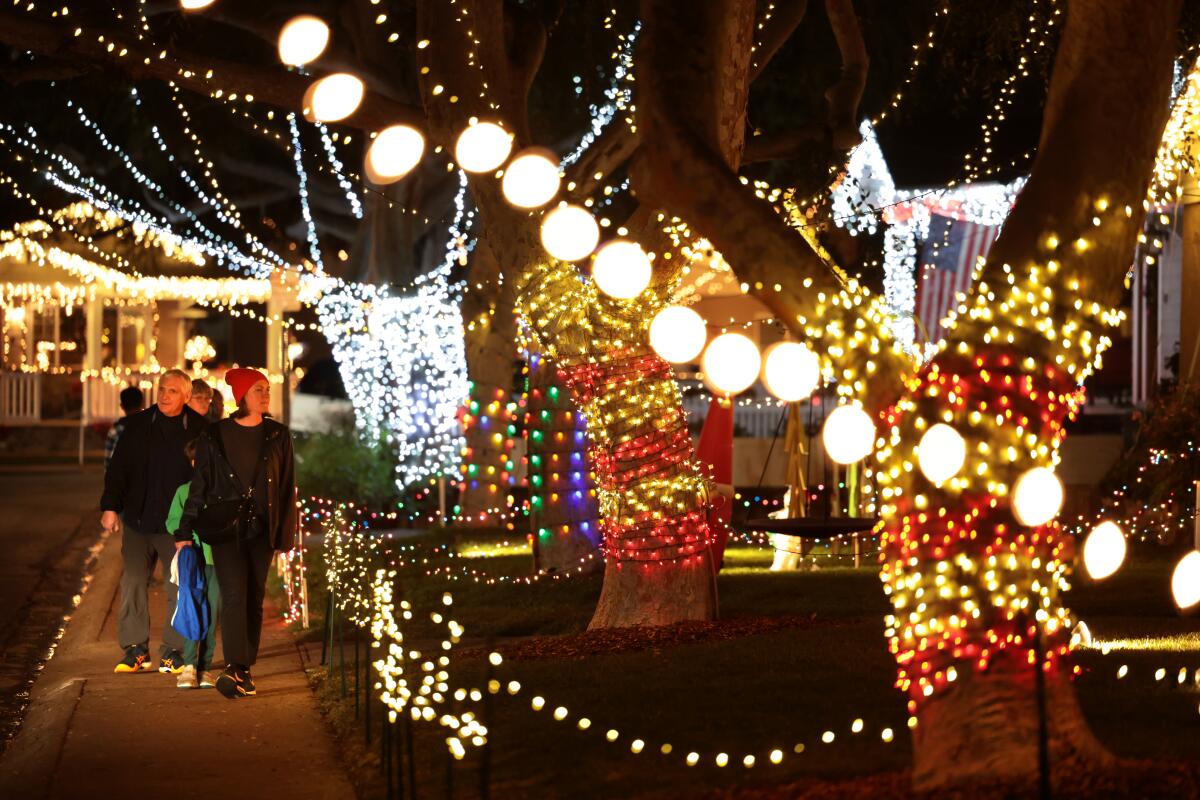Opinion: As Christmas and Hanukkah coincide, is it time for everyone to let there be holiday lights?

Hanukkah begins on Christmas this year, marking a rare coincidence of the Jewish and Christian holidays, which occur according to different calendars. The alignment invites reflection on how two traditions can inspire each other.
The Orthodox Jewish community I grew up in rejected Christmas lights as signs of unwanted assimilation. We lighted the menorahs in our windows and doorways for the holiday’s eight nights, keeping the tradition simple and understated. Any more showy displays would have felt like crossing a line.
Still, as a child, I secretly admired the glowing homes of my neighbors. But those lights weren’t for us — or so I was taught.
Even if I couldn’t find many Jews here in the Pacific Northwest, I could assemble friends who felt Jewish to me — an effort that feels urgent as antisemitism rises.
Decades later, I stand in my cul-de-sac and stare at my neighbors’ dazzling home, with warm, sparkling lights wrapped around the trees. They decorate their home for Christmas because it brings them joy — and, honestly, it brings joy to everyone who passes by.
Apart from menorahs and basic landscape lighting, most of the Jewish homes on the street stay dark during Hanukkah. We keep them that way out of habit, tradition and a lingering belief that holiday lights are “not Jewish.”
My kids don’t observe the rigid boundaries of my childhood, though. When we drive through the neighborhood, they’re drawn to the lights like moths to a flame, pressing their faces against the car windows and pointing out their favorite houses.
“Why don’t we have lights like that?” my 12-year-old, Rosa, asks, her voice full of wonder and betraying a hint of sadness.
I don’t have a good answer. Why don’t we?
Executives thought the ‘Peanuts’ special with no laugh track, lo-fi animation and a Bible passage was too slow and too serious. But audiences were craving an honest, heartfelt message.
Holiday lights have more than aesthetic benefits, signaling community and social connection. Lights can boost mood, reduce stress and create warmth, especially during the dark winter months. Holiday lights are more than decorations; they’re a means of emotional well-being. These seem like good reasons to rethink our traditions.
Judaism, however, emphasizes differentiation: Observing dietary laws, keeping the Sabbath and other practices make us stand out, reminding us — and others — of our identity. Critics claim holiday lights blur the distinction between Jewish and non-Jewish traditions.
Christmas lights descend from the candles once used to decorate Christmas trees, which in turn may have links to pre-Christian traditions. Ancient civilizations celebrated the winter solstice with evergreens and fires to mark the triumph of light over darkness. Christianity adopted some of these traditions, and starting in the late 19th century, electric light helped the holiday decorations become a secular cultural tradition in Europe, America and beyond.
While holiday lights have only become less specifically religious, they still carry strong associations with the Christian celebration of Jesus’ birth. Preserving Jewish identity in a world of cultural blending takes effort, and some worry that adopting symbols closely tied to Christmas undermines that work.
The tension between preserving Jewish distinctiveness and engaging with the rest of society isn’t new. Hanukkah itself celebrates an ancient Jewish victory over the Seleucid Empire, which sought to impose Hellenistic culture and forced assimilation in Judea.
But standing out doesn’t require rejecting every element of the broader culture. Light, after all, is universal. The Jewish tradition uses light as a symbol of hope and connection, not least at Hanukkah, often called the “Festival of Lights.” The menorah represented eternal light and divine presence in the ancient temple, and Hanukkah celebrates the miracle of a single day’s oil lasting eight. The public lighting of candles shares our story with the world — known in Hebrew as persumei nisa, publicizing the miracle. Even a small flame banishes great darkness.
Holiday lights may have religious roots, but today they also bring joy to people of all backgrounds. For Jewish families, embracing holiday lights doesn’t have to mean celebrating Christmas. It can be a way of enhancing our own traditions with a universal symbol of hope and illumination. Using blue and white lights or incorporating Jewish symbols like illuminated dreidels or Stars of David allows families to celebrate their traditions while connecting with their neighbors. It’s not about copying Christmas; it’s about marking Hanukkah in a shared language of light.
Jewish tradition is already replete with light. The third verse of the Torah says, “Let there be light,” emphasizing its centrality to creation. Isaiah calls the Jewish people “a light unto the nations,” urging us to spread hope and inspiration. So why limit ourselves to eight nights of candles? Why not let our lights burn brighter and longer, connecting us to our neighbors and reflecting the beauty of our traditions?
Growing up, we avoided holiday lights out of fear of losing something by blending in too much. Now I realize we won’t lose anything but darkness. It’s time to change; it’s time to shine.
Eli Federman is a writer and private equity investor. X: @EliFederman
More to Read
A cure for the common opinion
Get thought-provoking perspectives with our weekly newsletter.
You may occasionally receive promotional content from the Los Angeles Times.












